Table of Contents
ToggleIntroduction
Data science has become an integral part of decision-making processes in various industries. Python, with its extensive ecosystem of libraries, has emerged as a go-to programming language for data scientists. As we step into 2023, let’s explore the top 10 Python libraries that are revolutionizing Python projects for data science and empowering professionals to derive valuable insights from complex datasets.

Don't miss out on your chance to work with the best!
Apply for top job opportunities today!
Top 10 Python Libraries for Data Science in 2023
TensorFlow
TensorFlow, an open-source library for machine learning, is a powerhouse when it comes to building and training deep learning models. It offers a comprehensive set of tools for neural networks, computer vision, natural language processing, and more. TensorFlow’s versatility and scalability make it an indispensable tool for data scientists.
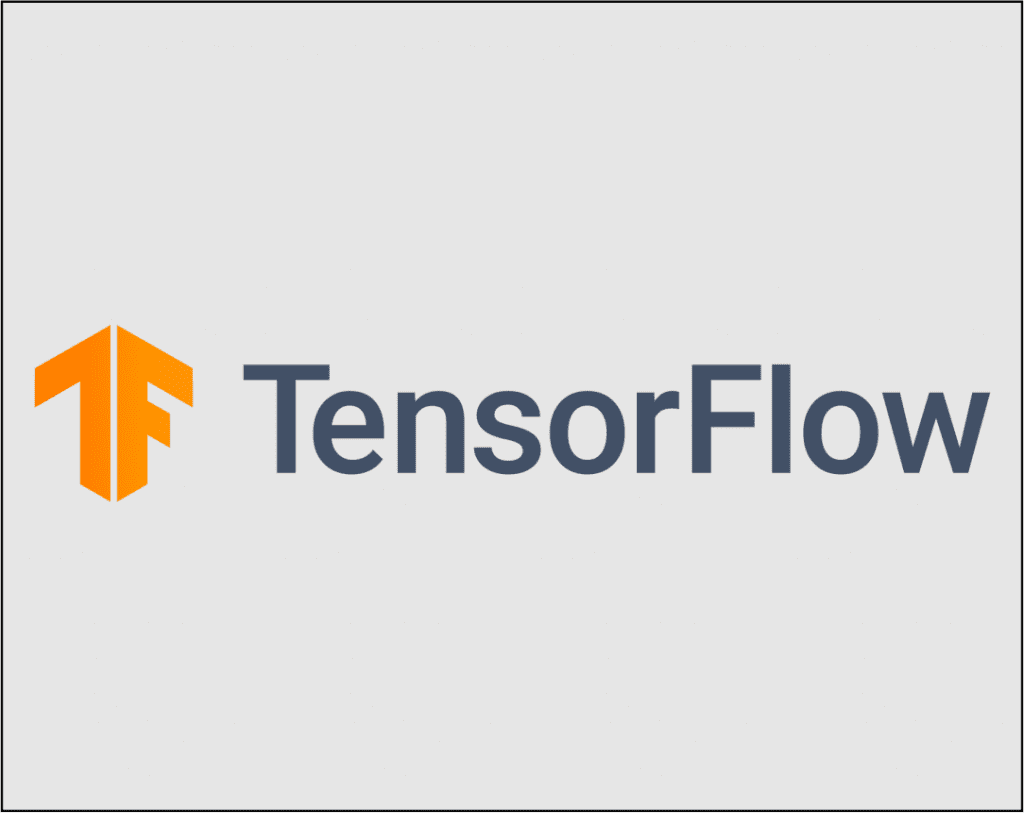
Some notable applications of TensorFlow include
- Image Classification: TensorFlow enables the development of deep learning models for image classification tasks. By utilizing convolutional neural networks (CNNs) and pre-trained models like VGG, ResNet, or Inception, TensorFlow empowers researchers and developers to create highly accurate image classifiers capable of recognizing and categorizing objects within images.
- Natural Language Processing (NLP): TensorFlow provides tools and resources to build NLP models. It supports the creation of recurrent neural networks (RNNs) and transformer architectures, allowing for tasks such as text classification, sentiment analysis, language translation, named entity recognition, and text generation. TensorFlow’s flexible computational graph architecture and optimization techniques contribute to efficient NLP model training and deployment.
- Object Detection: TensorFlow offers frameworks like TensorFlow Object Detection API that facilitate the development of object detection models. These models can detect and localize multiple objects within images or videos. Applications range from autonomous driving to video surveillance and image recognition systems.
- Generative Models: TensorFlow is extensively used to develop generative models like generative adversarial networks (GANs) and variational autoencoders (VAEs). GANs can generate realistic synthetic data, such as images or text, while VAEs enable data generation and latent space exploration. TensorFlow’s computational capabilities and optimization algorithms aid in training these complex generative models.
- Reinforcement Learning: TensorFlow is instrumental in building reinforcement learning models. It provides tools to define and train deep reinforcement learning algorithms, allowing researchers and developers to create intelligent agents capable of learning through interactions with an environment. Reinforcement learning applications include game playing, robotics, and optimization problems.
- Time Series Analysis: TensorFlow can be utilized for time series analysis tasks such as forecasting, anomaly detection, and pattern recognition. With recurrent neural networks (RNNs) and long short-term memory (LSTM) networks, TensorFlow enables the modeling of temporal dependencies in sequential data, making it suitable for applications like stock market prediction, weather forecasting, and sensor data analysis.
PyTorch
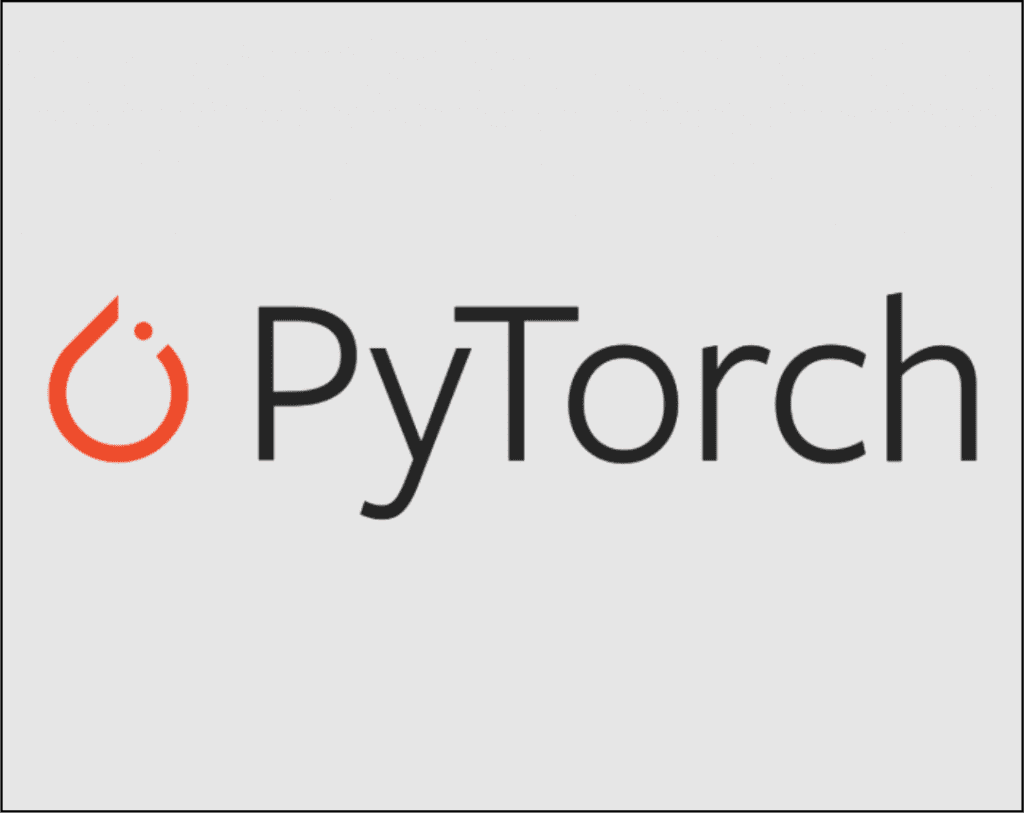
PyTorch is another popular library for deep learning, providing a dynamic, intuitive interface for building and training neural networks. With its seamless integration with Python, PyTorch enables researchers and developers to create complex models effortlessly. Its computational graph feature and extensive community support make it a favorite among deep learning practitioners.
Applications of PyTorch
- Computer Vision: PyTorch is widely used in computer vision tasks such as image classification, object detection, and image segmentation. It provides a flexible platform for building and training deep convolutional neural networks (CNNs) and leveraging pre-trained models like ResNet, VGG, and DenseNet for efficient feature extraction and image analysis.
- Natural Language Processing (NLP): PyTorch enables the development of NLP models for tasks like text classification, sentiment analysis, machine translation, and language generation. Its dynamic computational graph and extensive support for recurrent neural networks (RNNs) and transformers allow for flexible and efficient processing of sequential data, making it suitable for language-based applications.
- Generative Models: PyTorch is well-suited for building generative models such as generative adversarial networks (GANs) and variational autoencoders (VAEs). It provides a robust framework for training and generating synthetic data, allowing applications like image synthesis, text generation, and music composition.
- Reinforcement Learning: PyTorch is widely used in reinforcement learning applications, enabling the development of intelligent agents that learn to make decisions through interactions with an environment. Its dynamic computational graph and support for GPU acceleration facilitate efficient training of deep reinforcement learning models for tasks like game playing, robotics, and control systems.
- Time Series Analysis: PyTorch can be used for time series analysis and forecasting tasks. It supports the modeling of temporal dependencies using recurrent neural networks (RNNs) and attention mechanisms. This makes it suitable for applications such as stock market prediction, weather forecasting, and anomaly detection in time series data.
- Transfer Learning: PyTorch allows leveraging pre-trained models and transfers learning techniques. By using pre-trained models as a starting point, developers can fine-tune them on specific tasks or domains with limited data, reducing training time and improving performance. This is particularly beneficial when working with limited labeled data. These are just a few examples of the machine learning applications that PyTorch supports. Its intuitive interface, dynamic graph computation, and strong community support make it a popular choice for researchers and developers working on a wide range of machine-learning tasks.
Take control of your career and land your dream job!
Sign up and start applying to the best opportunities!

Pandas
Pandas is a fundamental library for data manipulation and analysis. It provides data structures like DataFrames, which allow for efficient handling and cleaning of structured data. Pandas simplifies tasks such as filtering, aggregation, and merging, making it a go-to library for data wrangling and exploratory data analysis.

Some Machine Learning Applications of Pandas
- Data Preprocessing: Pandas provides essential tools for data preprocessing, such as data cleaning, missing value imputation, feature scaling, and handling categorical variables. It enables efficient data wrangling and transformation, ensuring that data is in a suitable format for machine learning algorithms.
- Exploratory Data Analysis (EDA): Pandas is instrumental in conducting exploratory data analysis. It allows for data summarization, descriptive statistics, data visualization, and correlation analysis. With Pandas, analysts and data scientists can gain insights into the underlying patterns and relationships within the data, helping in feature selection and understanding the data’s characteristics.
- Data Integration and Transformation: Pandas facilitates the integration of disparate datasets by joining, merging, and concatenating data frames. It enables data transformation operations like pivoting, reshaping, and aggregating data, which are crucial in preparing data for machine learning tasks. Pandas’ flexible and expressive data manipulation capabilities streamline these data transformation processes.
- Feature Engineering: Feature engineering plays a crucial role in improving machine learning model performance. Pandas offers a rich set of functionalities to create new features, derive meaningful information from existing features, and handle time series or text data. Feature extraction, selection, and transformation tasks can be efficiently performed using Pandas’ operations and methods.
- Model Evaluation and Validation: Pandas aids in model evaluation and validation by providing tools to split datasets into training and testing sets, perform cross-validation, and compute evaluation metrics such as accuracy, precision, recall, and F1 score. It enables analysts and data scientists to assess model performance and make informed decisions about model selection and tuning.
- Data Integration with Machine Learning Libraries: Pandas seamlessly integrates with popular machine learning libraries like Scikit-learn and TensorFlow. It allows for easy data integration, transformation, and feeding data into machine learning models, enhancing the interoperability between Pandas and these libraries.
NumPy
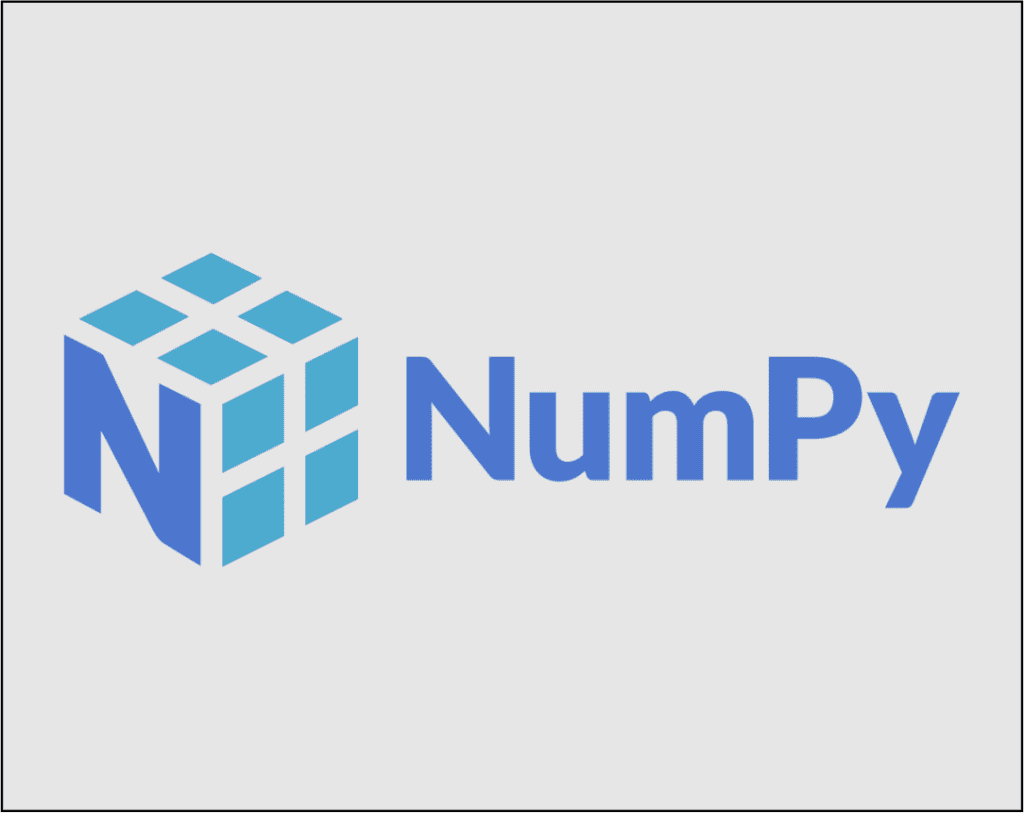
NumPy, short for “Numerical Python,” is a powerful library for numerical computing in Python. It provides an array object that allows for efficient manipulation of large, multi-dimensional datasets. NumPy’s mathematical functions, random number generation capabilities, and linear algebra routines make it a cornerstone of scientific computing in Python.
Applications of Numpy
- Data Manipulation: NumPy provides powerful tools for handling and manipulating multi-dimensional arrays, which are fundamental data structures in machine learning. You can perform various operations on arrays, such as reshaping, slicing, merging, and indexing, to preprocess and transform data before feeding it into machine learning algorithms.
- Numerical Operations: NumPy offers a wide range of mathematical functions and operations optimized for numerical computations. These include basic arithmetic operations, linear algebra functions, statistical operations, random number generation, and more. These functionalities are extensively used in machine learning algorithms for calculations and transformations of data.
- Feature Extraction: NumPy can be utilized for extracting features from raw data. For example, in computer vision tasks, you can use NumPy to perform operations like image resizing, cropping, filtering, and transforming. These operations are crucial for preprocessing images before extracting meaningful features for machine learning models.
- Linear Algebra: NumPy provides efficient implementations of linear algebra operations, such as matrix multiplication, matrix inversion, eigenvalue computation, and singular value decomposition (SVD). These operations are extensively used in machine learning algorithms, particularly in areas like regression, classification, and dimensionality reduction.
- Numerical Optimization: Many machine learning algorithms involve optimization procedures to find optimal parameters or solutions. NumPy’s optimization functionalities, such as gradient calculations and numerical solvers, can be utilized to implement optimization algorithms like gradient descent, stochastic gradient descent, and constrained optimization methods.
- Performance and Memory Efficiency: NumPy is designed to provide fast and memory-efficient operations on arrays. Its underlying C implementation and optimized algorithms enable efficient computations, making it suitable for large-scale machine-learning tasks. Many machine learning libraries in Python, such as scikit-learn and TensorFlow, rely on NumPy arrays for efficient data handling and computation.
Scikit-learn
Scikit-learn is a robust library for machine learning and predictive modeling. It offers a wide range of algorithms for classification, regression, clustering, and dimensionality reduction. With a unified and consistent API, Scikit-learn simplifies the implementation of machine learning models and supports end-to-end workflows, including data preprocessing and model evaluation.

Some Applications of Scikit-learn
- Classification: Scikit-learn offers a variety of classification algorithms such as Logistic Regression, Support Vector Machines (SVM), Random Forests, and Gradient Boosting. These algorithms can be used to build models that can classify data into different categories based on their features.
- Regression: Scikit-learn provides algorithms for regression tasks, including Linear Regression, Ridge Regression, Lasso Regression, and Support Vector Regression (SVR). These algorithms are used to build models that can predict continuous numerical values based on input features.
- Clustering: Scikit-learn includes popular clustering algorithms like K-means, DBSCAN, and hierarchical clustering. These algorithms group similar data points together based on their feature similarity, enabling you to discover natural clusters within your data.
- Dimensionality Reduction: Scikit-learn offers techniques for reducing the dimensionality of high-dimensional datasets, such as Principal Component Analysis (PCA), Linear Discriminant Analysis (LDA), and t-distributed Stochastic Neighbor Embedding (t-SNE). These methods can help visualize and understand complex datasets or preprocess data before applying other machine learning algorithms.
- Model Selection and Evaluation: Scikit-learn provides tools for model selection, including cross-validation, grid search, and performance metrics such as accuracy, precision, recall, and F1 score. These utilities help in selecting the best model and tuning hyperparameters for optimal performance.
- Natural Language Processing (NLP): Scikit-learn includes features for text processing and NLP tasks. It provides methods for feature extraction from text, such as TF-IDF (Term Frequency-Inverse Document Frequency) and bag-of-words representation. Additionally, it supports algorithms like Naive Bayes and SVM for text classification tasks.
- Anomaly Detection: Scikit-learn includes algorithms for anomaly detection, such as One-Class SVM and Isolation Forest. These methods can identify unusual or rare data points that deviate from the normal patterns in the dataset.
- Ensemble Methods: Scikit-learn provides ensemble methods like Random Forests, AdaBoost, and Gradient Boosting, which combine multiple weak models to create a stronger predictive model. Ensemble methods can improve the accuracy and robustness of machine learning models.
Matplotlib
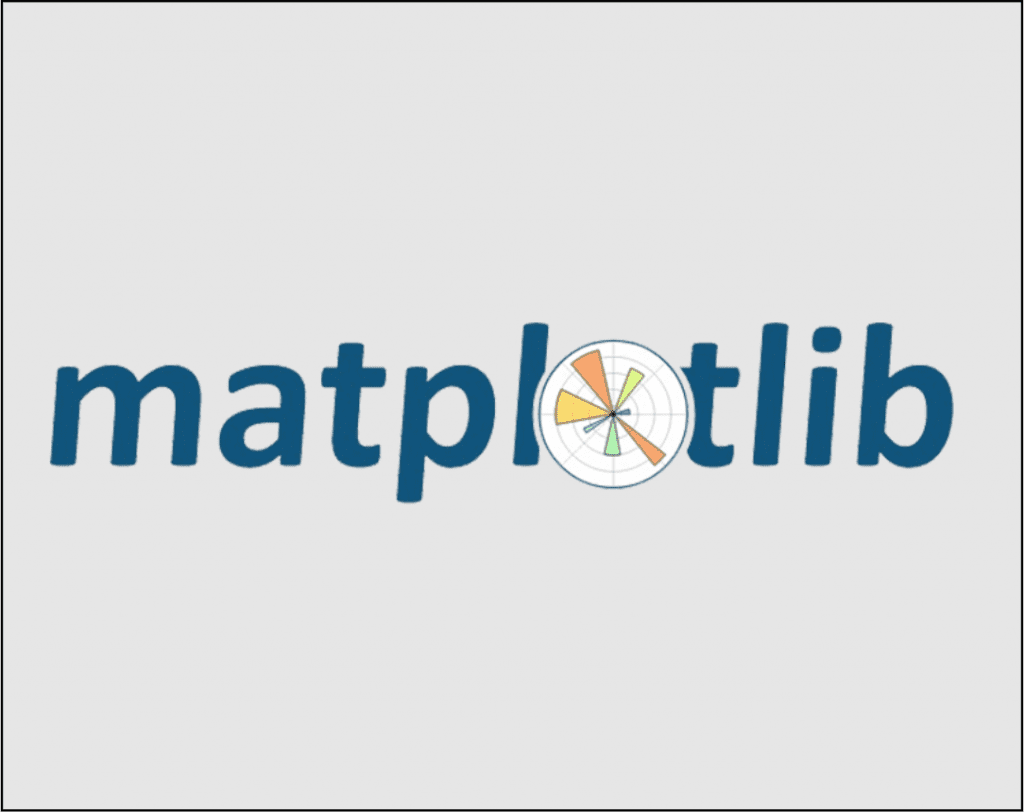
Matplotlib is a versatile visualization library that enables data scientists to create high-quality charts, plots, and figures. It provides a wide range of plotting functions and customization options, making it suitable for various visualization needs. Matplotlib integrates seamlessly with other libraries, such as Pandas and NumPy, and helps communicate insights effectively.
Applications of Matplotlib
- Data Exploration: Matplotlib provides powerful plotting capabilities, allowing data scientists to explore and visualize their datasets. They can create scatter plots, line plots, bar plots, histograms, and more to gain insights into the distribution, relationships, and patterns present in the data.
- Model Evaluation: Matplotlib is often used to visualize the performance of machine learning models. It enables the creation of precision-recall curves, receiver operating characteristic (ROC) curves, and confusion matrices, which help assess the accuracy and effectiveness of classification models.
- Feature Visualization: Matplotlib aids in visualizing the features or representations learned by machine learning models. It enables the creation of heatmaps, 2D and 3D scatter plots, and contour plots, helping researchers and practitioners better understand the underlying patterns and decision boundaries of their models.
- Model Interpretability: In order to understand how a machine learning model makes predictions, Matplotlib can be utilized to visualize the importance of contributions of different features. Feature importance plots, such as bar plots or violin plots, can be generated to highlight the relative significance of features in the model’s decision-making process.
- Time Series Analysis: Matplotlib’s capabilities for creating line plots and time series visualizations are beneficial in analyzing and forecasting time-dependent data. It allows researchers to plot trends, seasonality, and anomalies, helping them make predictions and identify patterns in time series datasets.
Seaborn
Seaborn is a statistical data visualization library built on top of Matplotlib. It offers a higher-level interface and a wide array of aesthetic options, making it effortless to create visually appealing statistical graphics. Seaborn excels in producing attractive visualizations for exploring relationships, distributions, and patterns in data.

Applications of Seaborn
- Seaborn provides visualization functions for Exploratory Data Analysis (EDA).
- Seaborn helps visualize distributions, correlations, and outliers in the data.
- EDA helps in data preprocessing, feature engineering, and model selection.
- Seaborn aids in Feature Engineering by understanding relationships between features and the target variable.
- Scatter plots and categorical plots in Seaborn help visualize the impact of features on the target variable.
- Seaborn offers visualization techniques for Model Evaluation.
- Regression plots can visualize predictions against actual values for regression models.
- Confusion matrix heatmaps and ROC curves help analyze the performance of classification models.
- Seaborn’s visualizations assist in assessing model strengths and weaknesses for informed decision-making.
- Seaborn’s visualization capabilities can be used for Hyperparameter Tuning.
- Line plots, bar plots, and box plots in Seaborn help observe the impact of hyperparameter settings on model performance.
- Seaborn’s visualizations aid in selecting optimal hyperparameter values based on metrics like accuracy, precision, recall, or F1 score.
- Seaborn is useful for creating visualizations for Reporting and Presentations.
- Visually appealing plots and customization options in Seaborn enhance the visual representation of analysis, model performance, and data-driven insights.
- Seaborn’s plot types and styling options support creating compelling visual representations for reports and presentations.
XGBoost

XGBoost, short for “Extreme Gradient Boosting,” is a powerful library for gradient boosting algorithms. It is highly efficient and widely used in Kaggle competitions and real-world applications. XGBoost excels in handling structured data and is known for its accuracy, speed, and ability to handle large datasets.
Here are some key machine-learning applications of XGBoost in bullet points
- Classification: XGBoost can be used for binary classification problems, where the goal is to classify data into two classes. It can also be extended to multi-class classification problems.
- Regression: XGBoost is effective for regression tasks, where the objective is to predict a continuous numerical value.
- Feature Selection: XGBoost can automatically rank and select important features from a given dataset, helping to identify the most relevant variables for a particular problem.
- Anomaly Detection: XGBoost can be utilized for identifying anomalies or outliers in a dataset, which can be valuable in fraud detection or network intrusion detection.
- Recommender Systems: XGBoost can power recommendation engines by learning patterns from user preferences and item characteristics to provide personalized recommendations.
- Time Series Forecasting: XGBoost can handle time series data and is effective in forecasting future values based on historical patterns, making it suitable for financial predictions, sales forecasting, and demand estimation.
- Natural Language Processing (NLP): XGBoost can be applied to NLP tasks such as sentiment analysis, text classification, and named entity recognition by transforming textual data into numerical features.
- Ranking: XGBoost can be used to build ranking models, where the goal is to determine the relevance or preference order of a set of items based on certain features.
- Image Processing: XGBoost can be combined with image feature extraction techniques to tackle image classification tasks, such as object recognition or image categorization.
- Click-Through Rate (CTR) Prediction: XGBoost has been successfully used in online advertising to predict the likelihood of a user clicking on a particular ad, enabling more targeted ad placements.
Statsmodels
Statsmodels is a library that focuses on statistical modeling and hypothesis testing. It provides a comprehensive suite of tools for regression analysis, time series analysis, and more. Statsmodels is a valuable asset for data scientists working on econometric or statistical projects, enabling them to perform detailed statistical analysis with ease.
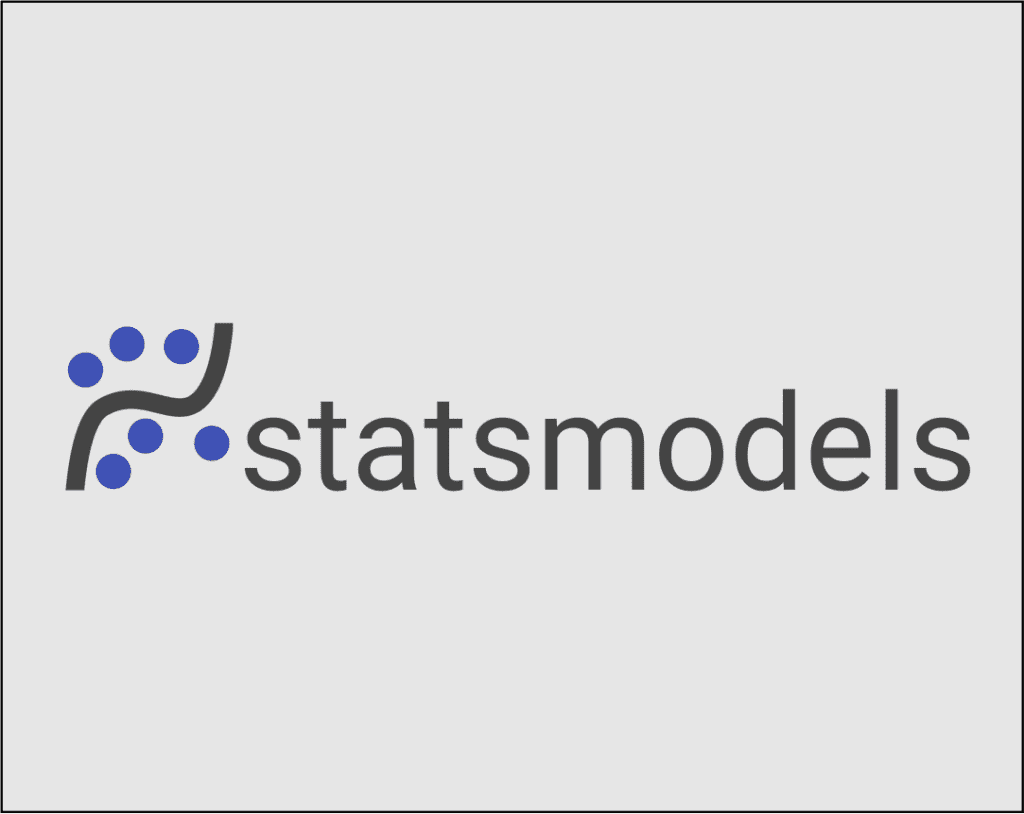
Here are some machine learning applications of Statsmodels
- Linear Regression: Statsmodels provides a comprehensive set of tools for performing linear regression analysis, including various extensions like weighted least squares, robust regression, and generalized least squares. It can be used for tasks such as predictive modeling, feature selection, and inference.
- Logistic Regression: Statsmodels supports logistic regression models for binary and multinomial classification problems. It can estimate parameters, perform hypothesis tests, and provide model diagnostics for logistic regression analysis.
- Time Series Analysis: Statsmodels includes a wide range of time series models such as ARMA (Autoregressive Moving Average), ARIMA (Autoregressive Integrated Moving Average), SARIMAX (Seasonal ARIMA with exogenous variables), and VAR (Vector Autoregression). These models are useful for analyzing and forecasting time-dependent data.
- Generalized Linear Models (GLM): Statsmodels offers a flexible framework for fitting GLMs, which extends the scope beyond linear regression to models such as Poisson regression, Gamma regression, and robust regression. GLMs are useful in scenarios where the response variable follows a non-normal distribution.
- Survival Analysis: Statsmodels provides tools for survival analysis, including Cox proportional hazards models and parametric survival models. These models are commonly used in medical research and reliability analysis to understand the time until an event occurs.
- Panel Data Analysis: Statsmodels supports models for analyzing panel or longitudinal data, such as fixed effects models and random effects models. These models are suitable for studying data with multiple observations over time or across different groups.
- Hypothesis Testing: Statsmodels offers a wide range of statistical tests, including t-tests, chi-square tests, ANOVA (Analysis of Variance), and more. These tests are essential for evaluating the significance of predictors, comparing groups, and assessing model fit.
NLTK
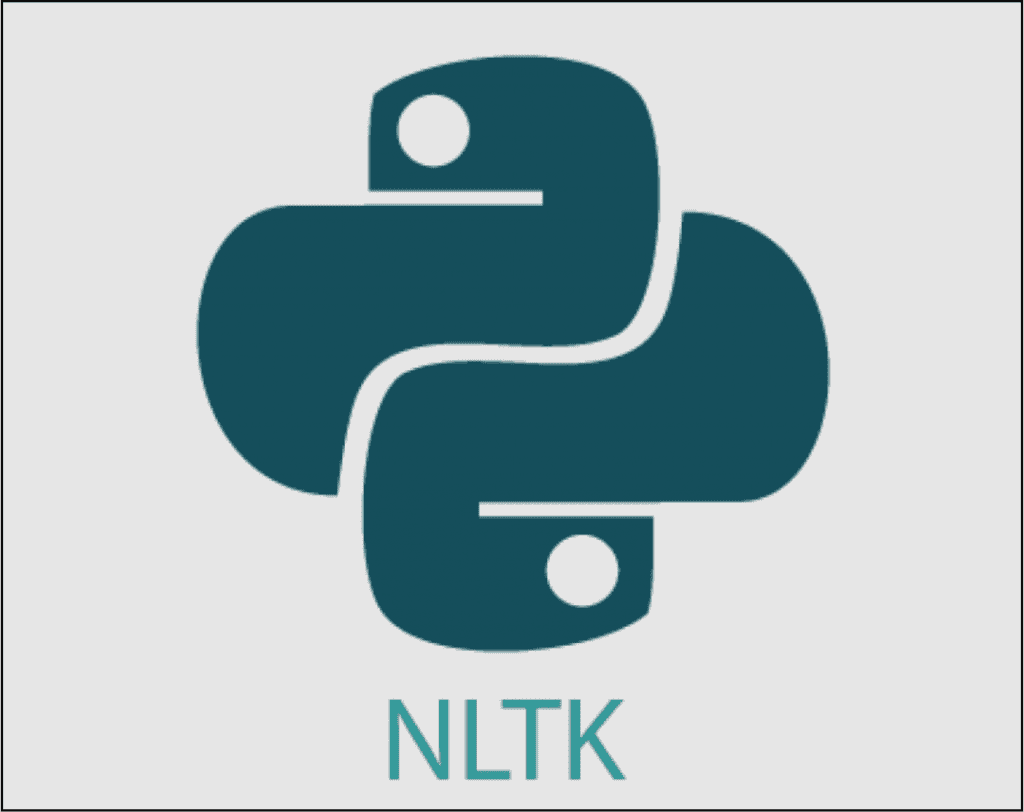
NLTK, short for Natural Language Toolkit, is a powerful Python library widely used for natural language processing (NLP) tasks. It provides a comprehensive suite of tools and resources to process, analyze, and manipulate human language data.
Here are some machine-learning applications of NLTK
- Text Classification: NLTK offers methods for performing text classification tasks such as sentiment analysis, spam detection, topic categorization, and document classification. It provides access to pre-trained classifiers and tools for feature extraction, making it easier to build machine-learning models for text classification.
- Named Entity Recognition (NER): NLTK includes modules for identifying and extracting named entities from text, such as people’s names, organizations, locations, and dates. NER is used in applications like information extraction, entity linking, and question answering systems.
- Part-of-Speech (POS) Tagging: NLTK provides POS tagging functionality, which assigns grammatical labels to words in a given sentence. This information is valuable for various NLP tasks, including syntactic parsing, word sense disambiguation, and machine translation.
- Topic Modeling: NLTK integrates with topic modeling algorithms such as Latent Dirichlet Allocation (LDA), which can automatically discover latent topics in a collection of documents. Topic modeling is useful for organizing and understanding large text corpora, recommendation systems, and content analysis.
- Language Modeling: NLTK allows you to build language models using n-gram models or more advanced techniques like hidden Markov models (HMMs) and conditional random fields (CRFs). Language modeling is crucial for tasks like text generation, machine translation, and speech recognition.
- Text Preprocessing: NLTK provides numerous text preprocessing capabilities, including tokenization (splitting text into words or sentences), stemming (reducing words to their base form), lemmatization (reducing words to their canonical form), and stop word removal. These preprocessing steps are fundamental in many NLP pipelines and machine learning models.
- Text Similarity and Clustering: NLTK offers tools for measuring the similarity between texts using techniques like cosine similarity, Jaccard similarity, or edit distance. It also provides clustering algorithms such as k-means, agglomerative clustering, and hierarchical clustering for grouping similar texts together.
- Sentiment Analysis: NLTK includes resources and lexicons for sentiment analysis tasks, allowing you to classify text based on positive, negative, or neutral sentiment. Sentiment analysis has applications in social media monitoring, brand reputation analysis, and customer feedback analysis.
- Machine Translation: NLTK supports machine translation tasks, enabling you to build statistical or neural machine translation models. You can train models using parallel corpora and leverage NLTK’s sequence alignment algorithms for alignment and decoding.
- Information Retrieval: NLTK provides tools for building information retrieval systems, including indexing, query processing, and relevance ranking algorithms. These systems are used in search engines, document retrieval, and recommendation systems.
Concluding Thoughts
To sum up, the field of data science has experienced remarkable progress, with Python emerging as the preferred programming language among data scientists. Python serves as a crucial language for software development related to machine learning, deep learning, and artificial intelligence. These Python libraries have not only simplified the implementation of complex algorithms but have also accelerated the development process, enabling data scientists to analyze vast amounts of data more effectively. With Python and its powerful libraries, data scientists are empowered to unlock valuable insights and make informed decisions, propelling the field of data science to new heights. If you are a Python developer looking for exciting data science jobs, sign up with Olibr now!
FAQs
Python is a high-level, general-purpose programming language known for its readability, expressiveness, and extensibility. Some key features include being free and open-source, supporting object-oriented programming, having a large community, and being easy to debug.
In Python, a library is a collection of precompiled code modules that provide specific functionalities. These libraries simplify complex tasks by offering a set of reusable functions, making programming more efficient.
A library management system project in Python involves creating a software application to manage information related to books, users, and transactions within a library.

